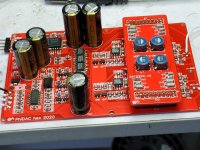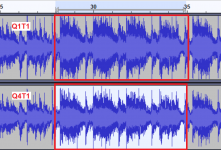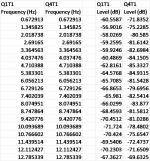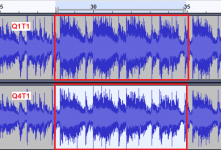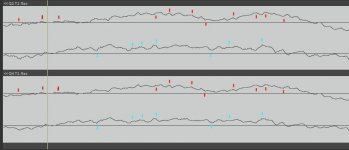I am trying to record a song played through the original Phidac and the Quad Version so I can share the files for you to listen to and see what difference you hear. However I am running into a problem that I can’t solve. If I record On pc from the iPhone there is no hiss but when I record from the Dac there is a hiss. I don’t believe it to be ground loop since I am feeding it with pc > usb > fibreoptic spdif > i2s decoder > Phidac > headphone amp.
It seems that with fiber optic there can be no ground loop. Any suggestions?
It seems that with fiber optic there can be no ground loop. Any suggestions?
Presumably the iPhone is being powered from its internal battery. What power supply is being used to feed the PhiDAC, I2S decoder and headphone amp? Ground loops can be AC not just DC - there can still be one via the PC's power supply and PhiDAC's power supply.
3rd order filter board
For those who really want to get the shortest ringing and don't much care about the shape of their higher frequency sinewaves we've designed this lower cost filter board. Its using off-the-shelf TDK inductors which have to be pre-selected (because their tolerance is +/-20%) with an LCR meter. The labour involved in measuring and selecting suitable inductors is considerably less than that in building up the 3 inductor board from the bare cores, leading to a cheaper DAC.
For those who really want to get the shortest ringing and don't much care about the shape of their higher frequency sinewaves we've designed this lower cost filter board. Its using off-the-shelf TDK inductors which have to be pre-selected (because their tolerance is +/-20%) with an LCR meter. The labour involved in measuring and selecting suitable inductors is considerably less than that in building up the 3 inductor board from the bare cores, leading to a cheaper DAC.
Attachments
This is going to be the most successful PhiDAC ever!
It might be also the best sounding so far. I understand that a complete filter board can be tested and sold separately, is this true? I am only wondering why there is a ground plane joining for both channel on the filter board. Is it intentional?
It might be also the best sounding so far. I understand that a complete filter board can be tested and sold separately, is this true? I am only wondering why there is a ground plane joining for both channel on the filter board. Is it intentional?
So you use the ad829 instead of something like OPA1612 just because they are cheapest in China with high speed and good specs?
Ad829 and most of the AD op amps are really expensive compared to the common but high-end chips like OPA1612 on sites like mouser, not sure why the pricing ends up that way
Ad829 and most of the AD op amps are really expensive compared to the common but high-end chips like OPA1612 on sites like mouser, not sure why the pricing ends up that way
It might be also the best sounding so far.
Not as good sounding to my (and my wife's ears) as the one with 3 inductors per channel. But that's just our subjective observation - if someone has an aversion to ringing that bias might influence them to hear the one with more ringing as worse on a sighted evaluation.
I understand that a complete filter board can be tested and sold separately, is this true?
I am planning to make both kinds of filters available as complete and tested yes. Or if a person has an LCR meter and plenty of inductors and capacitors available to them they can DIY it as the gerbers (BOMs, schematics) will be available. What won't be generally available is a kit of parts to build these filters as I can't see a way to do that economically.
I am only wondering why there is a ground plane joining for both channel on the filter board. Is it intentional?
Are you asking why there's only one groundfill when there are two audio channels? If so then I can't see a reason to split the groundfill - if you know of a good one, please share.
So you use the ad829 instead of something like OPA1612 just because they are cheapest in China with high speed and good specs?
No - if you examine the posted schematic you'll see I take output from pin5 of the opamp rather than the more usual pin6. OPA1612 has no such pin brought out.
Ad829 and most of the AD op amps are really expensive compared to the common but high-end chips like OPA1612 on sites like mouser, not sure why the pricing ends up that way
I don't know the background to ADI's pricing - just the recycled ones are extremely attractively priced here. They're not guaranteed to work though, I do find the occasional failure which is why I'll be including an extra one of each in the kit. You can order up some yourself if you find yourself a Taobao agent.
Thanks @abraxalito, it makes a sense. When new filter boards and kits will be available? I hope prices will be standarised and made public. Can you make a deal with one of the online retailers? This would solve problems with payments which I had last time.
I see you started liking these not expensive CM6635 interface boards for circa $15. Is it your current recommendation?
I see you started liking these not expensive CM6635 interface boards for circa $15. Is it your current recommendation?
One groundfill for two channels is a good practice, but pin connectors do not extend groundfill very well. In result we have two groundfills: one on the main board and a second on the filterboard. It is why I think that separating a ground on the filter board may be helping not spreading current peaks. As per your quote: "We shall not grow wiser before we learn that much that we have done was very foolish - F.A. von Hayek"Are you asking why there's only one groundfill when there are two audio channels? If so then I can't see a reason to split the groundfill - if you know of a good one, please share.
Last edited:
When new filter boards and kits will be available?
I'm aiming for around the middle of the month so between one and two weeks from now. Still working on the BOM and noticing design oversights as I write...
I hope prices will be standarised and made public.
I can't think of a reason why I wouldn't set out prices very clearly and explain what they pertain to. I'm not sure what 'standardized' means though.
Can you make a deal with one of the online retailers? This would solve problems with payments which I had last time.
I'm not sure what this means. We are looking into PayPal for those who don't mind paying the extra fees that we incur for using them. I think the fees will add 10-15% to the price.
I see you started liking these not expensive CM6635 interface boards for circa $15. Is it your current recommendation?
I don't recognize that number, I've been suggesting for a good length of time CM6631A-based boards which is what I currently use. Though its annoying as the S/PDIF output goes to sleep and stays there after the PC wakes from hibernation.
One groundfill for two channels is a good practice, but pin connectors do not extend groundfill very well. In result we have two groundfills: one on the main board and a second on the filterboard.
Yes that's unavoidable when going via connectors. I'm using a lot of pins in parallel though to mitigate it.
It is why I think that separating a ground on the filter board may be helping not spreading current peaks.
I'm not following you.
That was a typo. Sure I meant CM6631.I don't recognize that number, I've been suggesting for a good length of time CM6631A-based boards which is what I currently use. Though its annoying as the S/PDIF output goes to sleep and stays there after the PC wakes from hibernation.
Three gerber sets
Here are the gerbers for the PhiDAC hex baseboard plus for the two kinds of filter - 7th order using P14 cores and 3rd order with TDK inductors. I'm still going through the BOM, hope that'll be completed in the next 2 days.
Here are the gerbers for the PhiDAC hex baseboard plus for the two kinds of filter - 7th order using P14 cores and 3rd order with TDK inductors. I'm still going through the BOM, hope that'll be completed in the next 2 days.
Attachments
Compare Quad Phi to Original Phi
Dropbox - Audio Test - Simplify your life
In this folder I have recorded 5 songs.
The naming scheme is Q1 for original Phidac and Q4 for quad Phidac. There is a text file with the song names. They are 44.1 16bit.
I tried to keep the volume the same but some sound louder than others. Not quite sure why. I am very curious what you guys think. Can you hear a difference?
If there is a particular song you want compared, let me know and I will do a a/b recording of it.
Dropbox - Audio Test - Simplify your life
In this folder I have recorded 5 songs.
The naming scheme is Q1 for original Phidac and Q4 for quad Phidac. There is a text file with the song names. They are 44.1 16bit.
I tried to keep the volume the same but some sound louder than others. Not quite sure why. I am very curious what you guys think. Can you hear a difference?
If there is a particular song you want compared, let me know and I will do a a/b recording of it.
Original vs Quad Comparison
Hello Pelopidas,
Thank you for the shared files. I am not an expert and on top I have tinnitus, so take my conclusions with a grain of salt.
Setup: Laptop, Oehlbach USB DAC, ATHM50x headphones.
I heard Q1T1 and compared to Q4T1.
What I noticed was that Q1T1 has a tad more bass whereas Q4T1 sounded more subdued in that area, however there seems to be more separation of the sounds on Q4T1.
Next I heard Q1T3 and Q4T3 which i really like due to the great number of instruments and effects.
I got to say that while Q1T3 sounds good, there is more sound decay in the bass. When you listen to Q1T3 between 00.50 - 01.20 the guitar bass has more weight but muddled whereas in Q4T3 you can hear that string tightly pulled, released and transitioned to the next note.
On minute 02.00 to 02:30 one can hear in Q4T3 a tight lower frequency as the drum is being hammered.
I repeated then with the following setup: Laptop, Oehlbach USB DAC, Marantz 603 amp, Klipsch RP 600M.
The Klipsch speakers are very bright, and bring out a lot of the higher tone details (not so much the mids) and the lows too.
My impression was about the same but I got to say the detailed separation and that tight bass of the Quad is amazing with that kind of music.
I did a bit of comparison as well with Winamp and used the Plot spectrum analysis.
The frequencies remain the same across Q1 and Q4, what changes is the Level (dB)
Attached some screen shots
Hello Pelopidas,
Thank you for the shared files. I am not an expert and on top I have tinnitus, so take my conclusions with a grain of salt.
Setup: Laptop, Oehlbach USB DAC, ATHM50x headphones.
I heard Q1T1 and compared to Q4T1.
What I noticed was that Q1T1 has a tad more bass whereas Q4T1 sounded more subdued in that area, however there seems to be more separation of the sounds on Q4T1.
Next I heard Q1T3 and Q4T3 which i really like due to the great number of instruments and effects.
I got to say that while Q1T3 sounds good, there is more sound decay in the bass. When you listen to Q1T3 between 00.50 - 01.20 the guitar bass has more weight but muddled whereas in Q4T3 you can hear that string tightly pulled, released and transitioned to the next note.
On minute 02.00 to 02:30 one can hear in Q4T3 a tight lower frequency as the drum is being hammered.
I repeated then with the following setup: Laptop, Oehlbach USB DAC, Marantz 603 amp, Klipsch RP 600M.
The Klipsch speakers are very bright, and bring out a lot of the higher tone details (not so much the mids) and the lows too.
My impression was about the same but I got to say the detailed separation and that tight bass of the Quad is amazing with that kind of music.
I did a bit of comparison as well with Winamp and used the Plot spectrum analysis.
The frequencies remain the same across Q1 and Q4, what changes is the Level (dB)
Attached some screen shots
Attachments
Hi Abraxalito , please let us know when the boards are available and their pricing ...looking forward to the new design of the DAC
Hi katariat
I've been working on the pricing and its coming out as follows :
Kit for PhiHex mainboard with 7th order filter pre-built and tested : 560RMB ($79)
Kit for PhiHex mainboard with 3rd order filter pre-built and tested : 280RMB ($39)
Kit for PhiHex with both filters 645RMB ($91)
Shipping costs depend on your location and what speed of service you need.
I hope to be ready to accept orders early next week. Feel free to ask any further questions.
I've been working on the pricing and its coming out as follows :
Kit for PhiHex mainboard with 7th order filter pre-built and tested : 560RMB ($79)
Kit for PhiHex mainboard with 3rd order filter pre-built and tested : 280RMB ($39)
Kit for PhiHex with both filters 645RMB ($91)
Shipping costs depend on your location and what speed of service you need.
I hope to be ready to accept orders early next week. Feel free to ask any further questions.
Do you consider phase linearity essential to getting a more 'analog' sound?
This is post #93 from 2018. Ironically this is second time that I see phase linearity as a goal here even though audio quality is the main interest in whole site. Other one was jbau's analog power supply experiment based on LT1085/LM337 (circuit schematic a few post below). According to his experiments, more phase linear power supply in audio band, more detail and holographic presentation attained. I just wanted to notice that.
Last edited:
Are these ripped vinyl?
T5 seem to be different tracks?
//
T5 seem to be different tracks?
//
Dropbox - Audio Test - Simplify your life
In this folder I have recorded 5 songs.
The naming scheme is Q1 for original Phidac and Q4 for quad Phidac. There is a text file with the song names. They are 44.1 16bit.
I tried to keep the volume the same but some sound louder than others. Not quite sure why. I am very curious what you guys think. Can you hear a difference?
If there is a particular song you want compared, let me know and I will do a a/b recording of it.
Last edited:
- Home
- Source & Line
- Digital Line Level
- lingDAC - cost effective RBCD multibit DAC design
